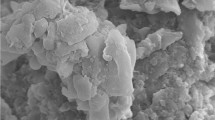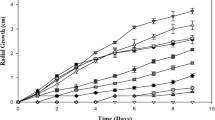Abstract
An industrial strain of Saccharomyces cerevisiae collected from the waste of a brewing industry was used to remove lead, cadmium and copper from aqueous solutions (1 mm).
Metal removal efficiency by using either biomass suspension directly diluted into the metal solutions or biomass previously incubated and washed in distilled water was compared. In all experiments with unwashed biomass a shift in the medium pH from 4.5 to a final value in the 7.0–8.0 range occurred. This pH increase was responsible for a metal precipitation effect associated to the metal biosorption. A very different pH profile was observed when washed biomass was used leading to different removal profiles for Cd2+ and Pb2+ and a similar one for Cu2+. In the absence of biomass, medium components and/or the excreted intracellular products proved to interfere in the metal removal and to be responsible for 80% Pb2+ precipitation, in the pH 4.5–5.0 range.
To initial metal solution pH, leading to the lowest residual ion concentrations, after 96 h of contact with unwashed biomass and in the absence of pH adjustment, was 4.5–5.0. Continuous or stepwise adjustment of medium pH to this range during the process was unfavourable for metal removal, being the continuous adjustment the worst procedure. In this case, Cd2+ was not biosorbed and Cu2+ removal decreased from 76 to 33%. However, Pb2+ was always extensively removed (89%) and only slightly affected by pH control.
The global results suggest different removal mechanisms for each cation. Cu2+ was removed by both metal sorption and precipitation, due to the pH shift that occurred during the process, while Cd2+ removal showed to be completely dependent of this pH shift. Pb2+ was totally and quickly removed, by precipitation, in the presence of the biomass suspension and at pH 4.5.
Moreover, the biosorbent changes occurring during the process played an important role in the metal removal when non-viable microbial biomass is used.
Similar content being viewed by others
Author information
Authors and Affiliations
Additional information
Received: 19 July 1999
Rights and permissions
About this article
Cite this article
Marques, P., Rosa, M. & Pinheiro, H. pH effects on the removal of Cu2+, Cd2+ and Pb2+ from aqueous solution by waste brewery biomass. Bioprocess Engineering 23, 135–141 (2000). https://doi.org/10.1007/PL00009118
Issue Date:
DOI: https://doi.org/10.1007/PL00009118




